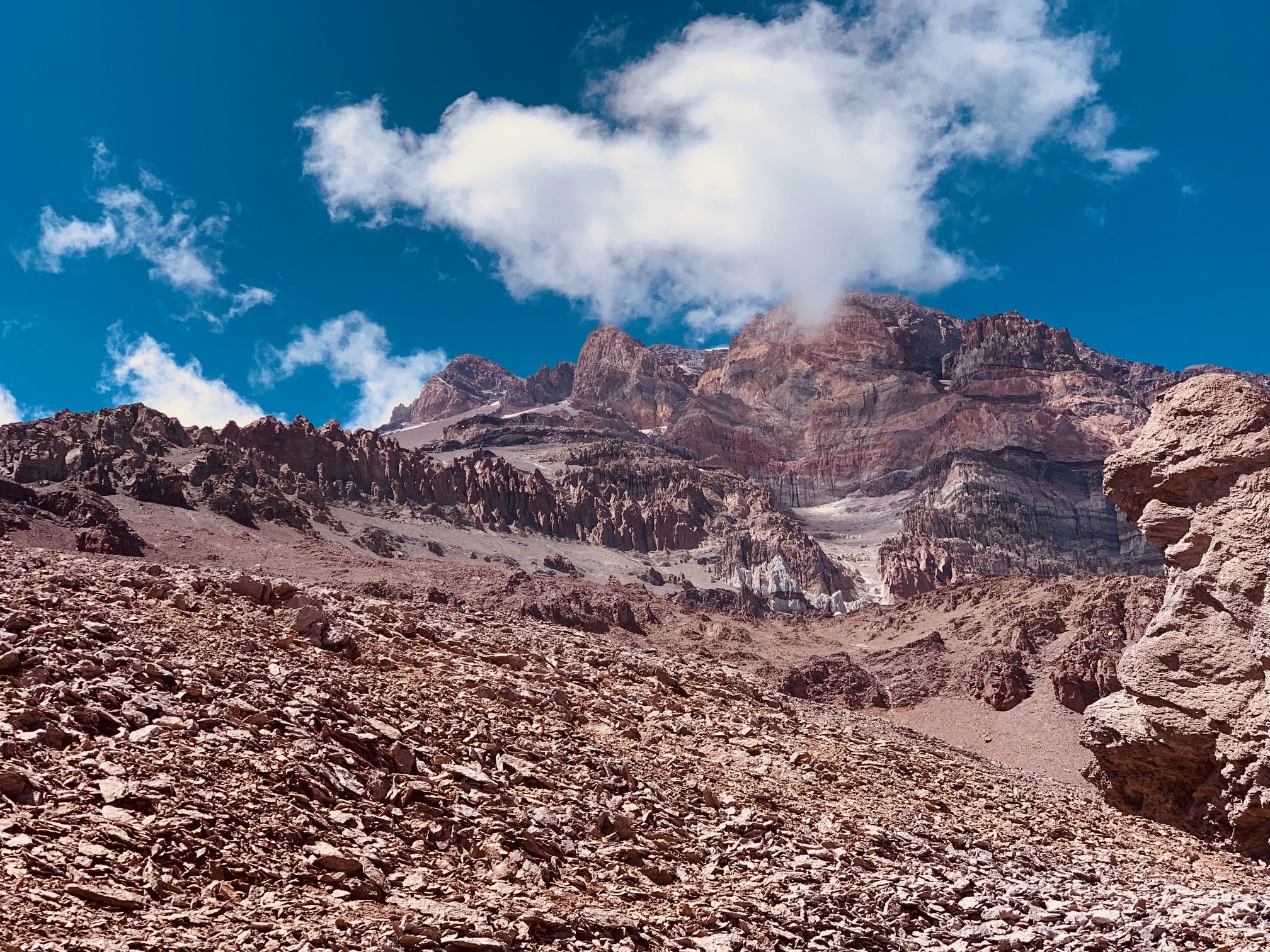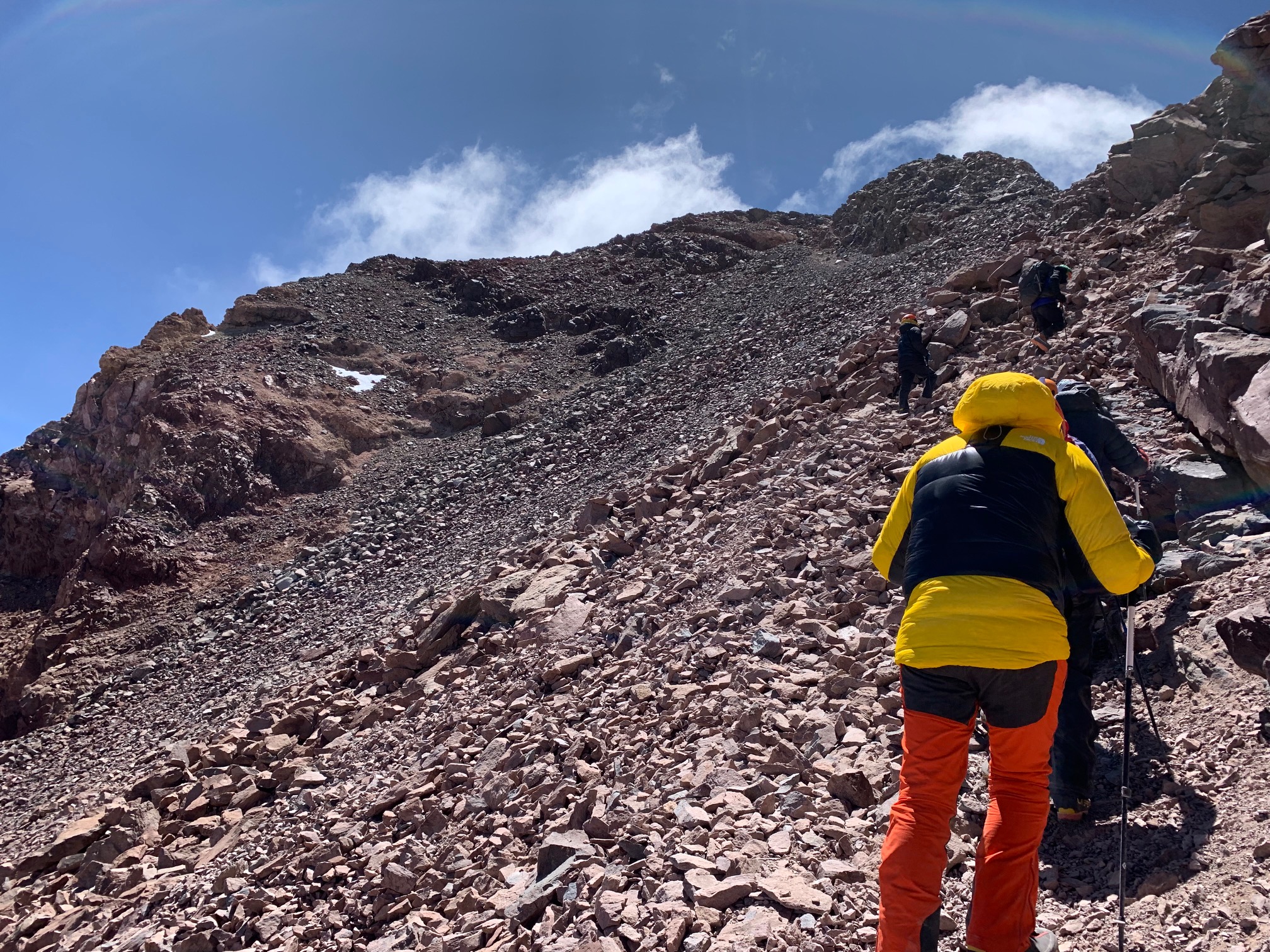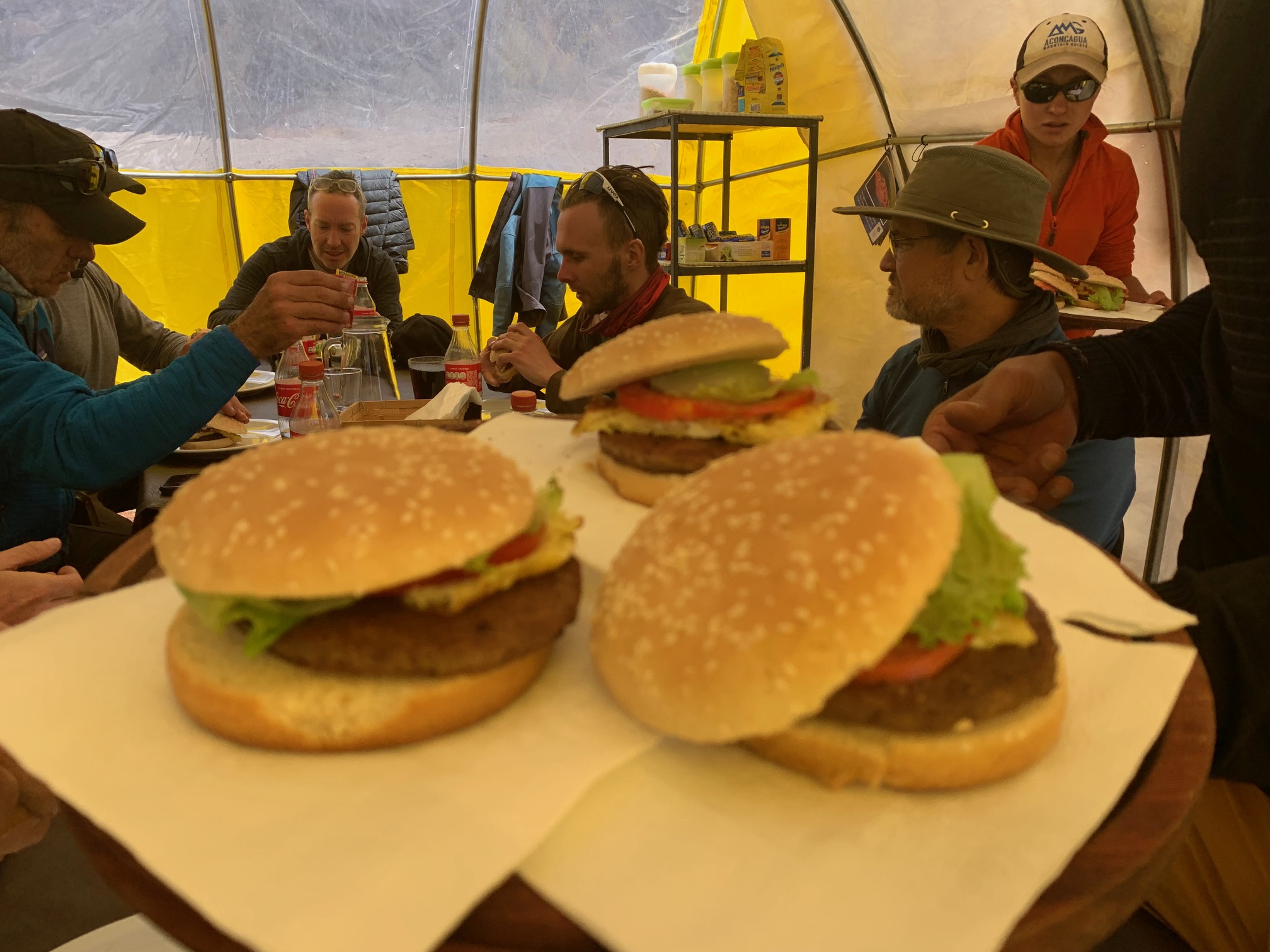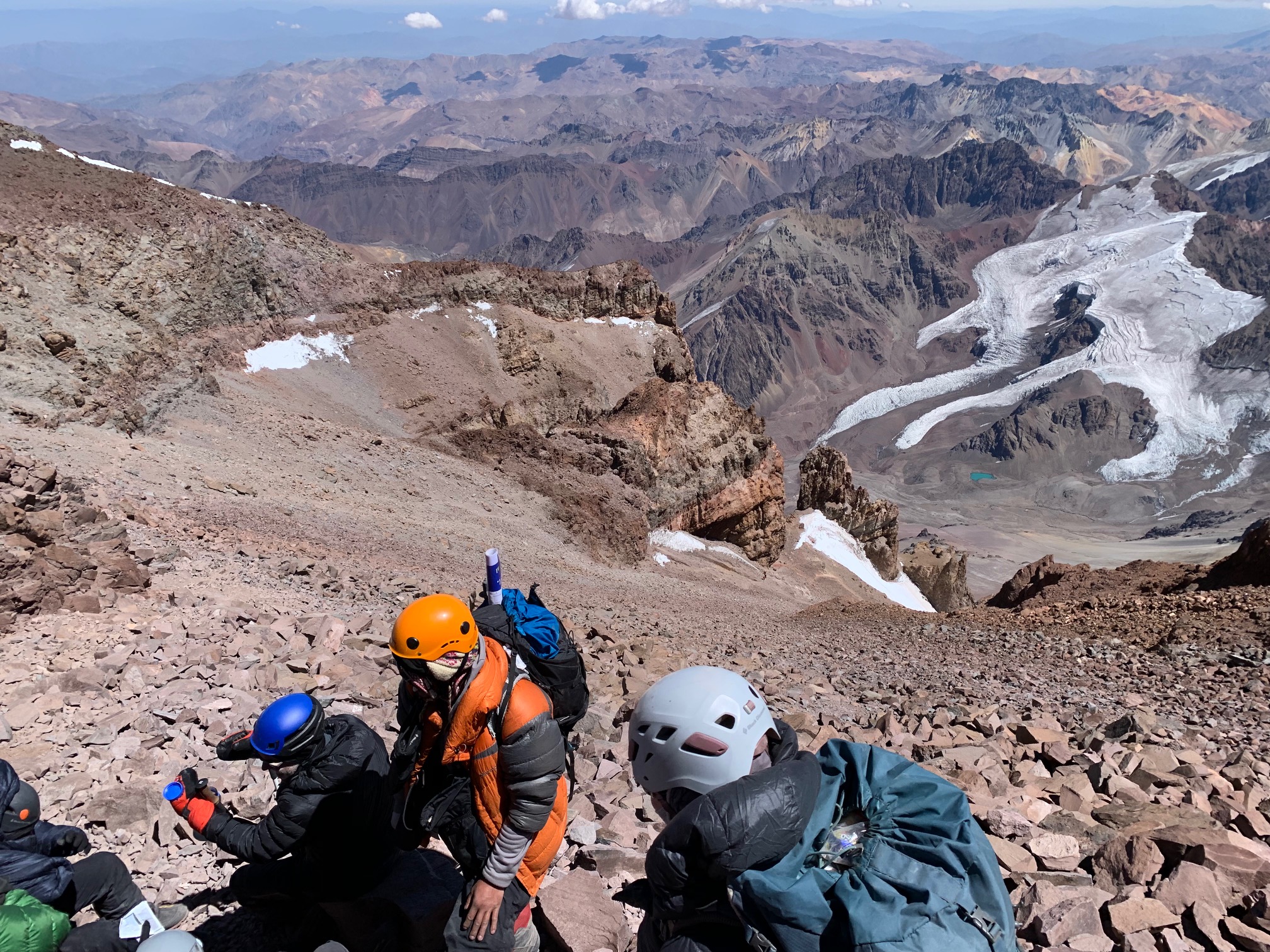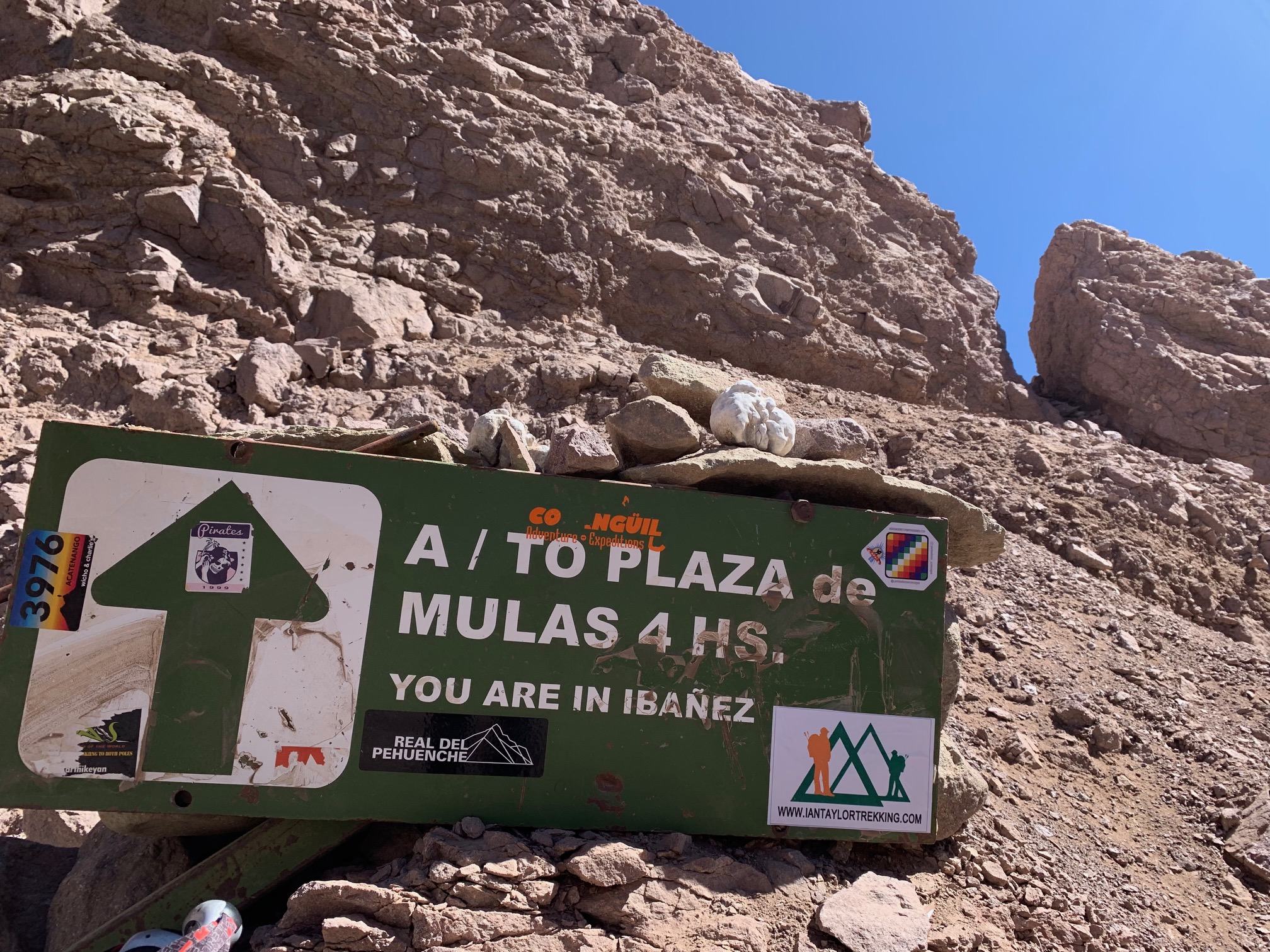Elevations gains for climbing Mount Aconcagua is important, so you can use this information to plan your training program. When developing a training plan you need to understand a few things. Read below and then get in touch with us for further information. Read some reviews from our trips. We highly recommend climbing Aconcagua on the Vacas valley traverse.
Day 1). Arrive in Mendoza
Today we will arrive in Mendoza at 760m/ 2,493 feet. We will be waiting for you at the airport with an Ian Taylor Trekking banner. We will transfer you to the Diplomatic Hotel in the heart of Mendoza. On this day, normally at 4pm our guides will check all of your mountain equipment and accompany you to hire the necessary things if needed. One of our staff members will arrive and gather permit money, along with copy of your passport and Insurance or helicopter evacuation card after all the formalities you will enjoy the comforts of one of the best hotels in Mendoza City. (Food is not included)
Day 2). Hike up to 2,800m / 9,186 feet
We will have a staff member managing your permit. This can take some time so you can relax in the hotel, have breakfast and around 10am we will be underway. We will drive up into the mountains at Uspallata for lunch and then continue to drive up to Penitentes at 2,600m/ 8,530 feet. We will stay at the Ayelen Hotel. There is a chance to take an optional walk up a little higher to stretch the legs before dinner. Dinner will be set for around 7pm. Time to relax, have a shower and rest before we start hiking the following morning. Drive up 1,840m/ 6,037 feet. Elevation gain hike up and down 200m / 656 feet.
Day 3). Hike to Pampa De Lenas 2,868m/ 9,404 feet
We will be up for breakfast at 8/9am and probably load into the vehicle at 10am and take the short drive to the trail head 2,400m/ 7,874 feet at the start of the Vacas valley. From the start of the trail it is 7.9 miles to Pampa De Lenas at 2,868m/ 9,404 feet. The group will be taken to the entrance of the Park in a private vehicle where permits will be presented and you will start with the trek to the Pampa De Lenas Camp. The equipment will be carried by mules and we will have lunch on the way. On arrival in camp, you will set up your tent with your partner and will be able to rest and enjoy some BBQ for dinner. Elevation gain up 468m/ 1,545 feet.
Day 4). Hike to Casa De Piedra 3,245m/ 10,646 feet
We will probably set breakfast for 9am and all tents will need to be taken down before breakfast so they can be loaded onto mules. Today is a 9.4 mile hike to Casa de Piedra. We cross the river and follow the valley all the way to our next campsite at Casa de Piedra at 3,245m/ 10,646 feet. This trek is about 6 hours. Like the previous day, the tents will need to be set up and you will be able to rest waiting for dinner to be ready. You can wash cloths and enjoy this unique campsite while the guides prepare your dinner. Elevation gain up 377m/ 1,237 feet.
Day 5). Hike to Aconcagua Base Camp 4,200m/ 13,780 feet
Today is a beautiful trek up to the Plaza Argentina Base Camp at 4,200m/ 13,780 feet which takes approximately 6/7 hours. This will be our Base Camp on the mountain for four nights. Today is the cold river crossing. We will pack everything up and move across the river bed towards Aconcagua. After crossing the river we go uphill for a while and then gradually move slowly towards base camp. Our base camp has showers, WiFi, bbq and quality comfortable dining tents stocked with everything you need to be comfortable for your stay in Base Camp. It is important to take it easy and stay well hydrated each day drinking 5 liters of water. This is a very dry climate. Elevation gain up 955m/ 3,133 feet.
Day 6). Rest and Acclimatization Day
Today is a rest day in the Plaza Argentina Base Camp. You will be able to rest during the whole day, shower, read and prepare your gear for moving higher on the mountain. After breakfast you can go sightseeing around the area, and contemplate the beauty of the mountain and surrounding area. There is a boulder rock close by and you can enjoy this amazing valley. It is worth getting out and keep moving around while at altitude. Lunch and dinner times will be set on the day. No Elevation gain today.
Day 7). Hike to Camp 1 4,950m/ 16,240 feet
Today is our first load carry. You will take part of the group equipment to Camp 1. You will be carrying food, fuel and camp equipment needed high on the mountain. This is usually around 8kg/ 17lbs to 10kg/ 22lbs and you can carry some of your own equipment like mountaineering boots, crampons, summit gear with you. You do not want to be carrying more than 16kg/ 25lbs on this first load carry.
The journey up to Camp 1 4,950m/ 16,240 feet takes about 4 hours. On arrival you will enjoy your packed-lunch and then return to Plaza Argentina. This hike will greatly benefit you during the acclimatization process as well as help bring equipment needed higher up the mountain. You will need to visit the doctor in Base Camp today and they will check your oxygen saturation, heart rate, lungs and blood pressure. Elevation gain of 750m/ 2,460 feet up and down.
Day 8). Rest and Acclimatization Day
Today is another rest day in Plaza de Argentina. You can take a walk near base camp, rest up, shower and start thinking about all the gear you need for higher on the mountain. This is the day, you will make sure that your equipment is ready to either higher and prepare your duffel bag to go lower. Once your duffel bag leaves it will meet you in Plaza du Mules, the base camp on the other side of the mountain. This is your last chance to use WiFi and rest up so as to be strong enough for the next days that demand much more effort. No elevation gain today.
Day 9). Hike to Camp 1 4,950m/ 16,240 feet
After a nice breakfast we will prepare ourselves to move higher on Aconcagua. You will be carrying all your remaining personal expedition gear with you up the mountain. After approximately a 4 hour trek, you will arrive back in Camp 1 4,950m/ 16,240 feet. On the way, the group will have lunch and once you arrive, you will set up the tents with the guides help. You will start to feel the altitude effects on your body, so really important to be drinking 5 liters of water and rest up before dinner which the guides will prepare. Elevation gain up 750m/ 2,460 feet.
Day 10). Hike to Camp 2 5,550m/ 18,044 feet
Today, the group will climb up to the Upper Guanacos and make the long traverse to Camp 2 at 5,500m/ 18,045 feet. We will be carrying group equipment to Camp 2. This load carry will be around 5kg/ 11lbs to 7kg/ 15lbs. You can also carry some personal gear, crampons, mountaineering boots and summit clothing. You do not want this to be more than 14kg/ 31lbs. We will have lunch on the way, take some rest in Camp 2 and then return to camp 1 for the night. This will take 6/7 hours to make the return journey. The guides will prepare dinner in camp 1 and you will need to rest. Elevation gain of 550m/ 1,804 feet up and down.
Day 11). Hike to Camp 2 5,500m/ 18,044 feet
We will be back on the move again. We will back up your remaining personal gear as we will be moving to camp 2. Breakfast will be set for 9am and the plan will be to move to camp 2 around 11am. We will need to wait for porters to come up to carry some group equipment and tents and we will start moving to camp 2. The tent will need to taken down and left for the porters. Elevation gain of 550m/ 1,804 feet up.
Day 12). Rest and Acclimatization day
Today is a full rest day in camp 2 at 5,500m/ 18,045 feet. It is important to keep drinking a lot of water, resting and if weather allows take a short, slow hike up above camp to acclimatize. Resting and hydrating should be your number one concern today. You can now on the edge of extreme altitude and need to be monitoring yourself before moving higher. Some of the guides will carry water maybe 40 liters up to camp 3 at 5,980m/ 19,620 feet. No elevation gain today.
Day 13). Hike up to 5,980m/ 19,620 feet
Depending on weather forecast and winds we may do a small load carry to Camp 3 at 5,980m/ 19,620 feet. We will have breakfast, and start ascending towards the Normal Route. Camp 3 is strategically located for its altitude and protected from strong winds. Depending on the weather we will drop gear, eat some lunch and return to Camp 2. We maybe staying at Camp 3 but this depends on weather and the plans for the summit attempt. Elevation gain of 480m/ 1,575 feet up and down.
Day 14). Hike up to 5,980m/ 19,620 feet
Depending on summit plans you maybe be already in camp 3. Today is the day we will pack up camp 2 and move remaining personal gear to camp 3. There should be no need to carry any group equipment at this stage. Our goal will be to leave Camp 2 by 11am and slowly make our way to camp 3. This should take about 3 hours. Elevation gain of 480m/ 1,575 feet up.
Day 15). Summit Attempt 6,962m/ 22,841 feet
Climb from Camp 3 to the summit of Aconcagua at 6,962m/ 22,841 feet and return to Camp 3. We aim to leave at 5am and make the 8 hour hike to the summit of Aconcagua. This is an extremely difficult day and usually underestimated by a lot of people. The group will get up very early in the morning, have breakfast and start climbing. Our goal is to reach the summit by 1pm where you will live an unforgettable experience of reaching the highest point in the world outside of the Himalaya’s. After a short time on the summit, we will return to Colera Camp. You will sleep that night with the satisfaction of having reached your goal of reaching South America’s highest point. Elevation gain of 982m/ 3,222 feet up and down.
Day 16). Hike Down to Plaza de Mulas Camp 4,400m/ 14,435 feet
Today we will get up early, have breakfast and the team will descend back to the Plaza de Mulas Base Camp at 4,400m/ 14,435 feet after a long trek. This can take anywhere from 3 to 4 hours. You will be carrying all your own personal gear. You will arrive back in base camp by 2 or 3pm. The group will have the day free to share those emotions experienced throughout the expedition. Take a shower use WiFi and rest up before a good nights sleep. During this day you will only carry your personal equipment, because our porters will be in charge of carrying all the group equipment including the garbage down to Plaza de Mulas base camp. Elevation drop of 1,580m/ 5,184 feet.
Day 17). Hike to the Road 2,950m/ 9,678 feet
Today is the long descent 26km/ 16 mile hike to Laguna Horcones and complete the Aconcagua journey. Your belongings will be carried by mules so you will only take a light bag pack with a fleece, rain gear, water and your packed lunch. From the end of the trail you will be transferred by private vehicle to Mendoza city and stay an the Diplomatic Hotel. Elevation drop of 1,450m/ 4,757 feet.
Day 18). Rest and Recover
Today is the last day of the trip and you will be transferred back to the airport for your international flight home. You can explore Mendoza and join one of our Wine tours. You should plan on having some spare days in case they are needed on the mountain because of bad weather.
Day 19). Contingency Day
Extra day for contingencies that may prevent the normal development of the program.
Day 20). Contingency Day
Extra day for contingencies that may prevent the normal development of the program.
Day 21). Time to Leave Mendoza
This is the day you need to book your flight for and no sooner. We may need all the extra days for a summit attempt.
Join us on Aconcagua
Does this information about climbing Aconcagua The Vacas Valley route excite you? Take the next step towards achieving your goals in the mountains? If so, get in touch today. We pride ourselves on making sure that our clients have every opportunity to succeed on the mountains, including professional training advice, itemized kit list and video links on what to pack, and much more. We are always available to answer any questions you may have by email, phone or skype, so contact us today!

